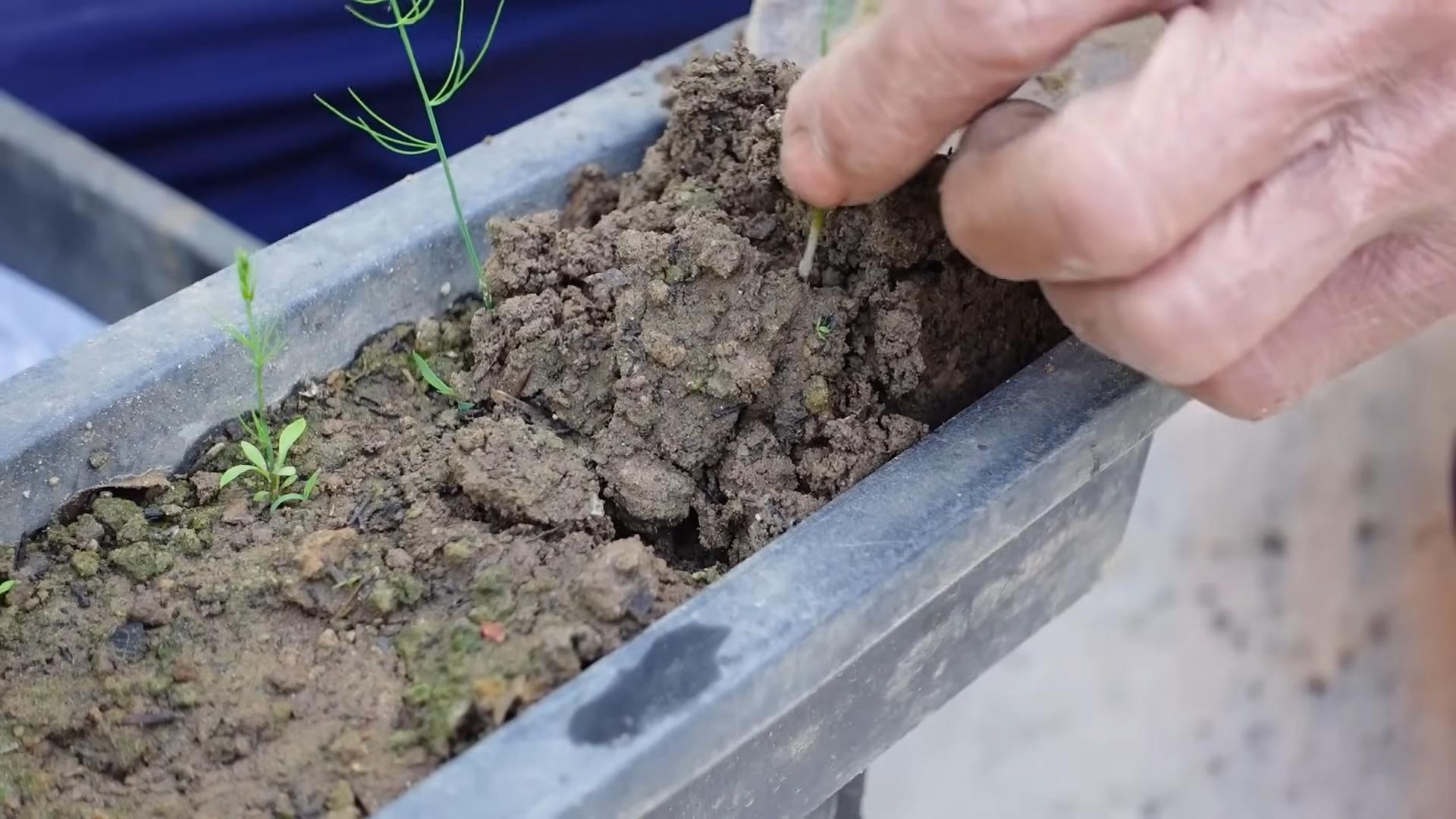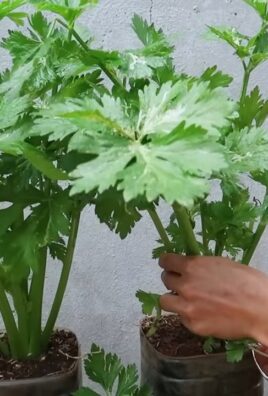Grow Asparagus at Home and unlock a world of fresh, flavorful spears right in your backyard! Imagine stepping outside and harvesting your own delicious asparagus, knowing exactly where it came from and how it was grown. Forget those limp, expensive bundles at the grocery store – with a little know-how, you can cultivate a thriving asparagus patch that will provide you with years of delectable harvests.
Asparagus has a rich history, dating back to ancient Greece and Rome, where it was prized for its medicinal properties and culinary delights. The Romans even developed sophisticated methods for forcing asparagus to grow out of season! Today, the joy of growing your own food, especially something as unique as asparagus, is experiencing a resurgence. More and more people are turning to home gardening, not just for the cost savings, but for the satisfaction of nurturing something from seed (or crown!) to table.
But why should you learn to grow asparagus at home? Well, for starters, fresh asparagus is simply unbeatable in taste and texture. Plus, growing your own allows you to control the entire process, ensuring that your asparagus is free from harmful pesticides and herbicides. In this article, I’m going to share some simple yet effective DIY tricks and hacks that will help you establish and maintain a flourishing asparagus bed, even if you’re a complete beginner. Get ready to enjoy the unparalleled taste of homegrown asparagus – it’s easier than you think!

Growing Asparagus: A Beginner’s Guide to a Delicious Home Harvest
Asparagus! Just the word conjures up images of spring, fresh flavors, and maybe even a fancy brunch. And guess what? You don’t need a sprawling farm to enjoy homegrown asparagus. I’m going to walk you through everything you need to know to successfully grow asparagus right in your own backyard (or even in containers!). It might seem daunting at first, but trust me, with a little patience and the right approach, you’ll be harvesting delicious spears for years to come.
Planning Your Asparagus Patch
Before we get our hands dirty, let’s talk planning. Asparagus is a perennial, meaning it comes back year after year. This is fantastic, but it also means choosing the right location and preparing the soil properly is crucial. Think of it as making a long-term investment in deliciousness!
* Sunlight: Asparagus needs at least 6-8 hours of direct sunlight per day. The more sun, the better!
* Soil: Well-drained soil is essential. Asparagus crowns hate sitting in soggy soil, which can lead to root rot. Aim for a slightly sandy loam.
* Space: Asparagus plants can get quite large over time, so give them plenty of room to spread out. I recommend at least 4 feet between rows and 12-18 inches between plants within a row.
* Patience: This is the big one! Asparagus takes a few years to mature before you can start harvesting heavily. Don’t get discouraged! Think of it as delayed gratification.
Getting Started: Seeds vs. Crowns
You have two main options for starting your asparagus patch: seeds or crowns.
* Seeds: Starting from seed is the most economical option, but it takes longer. You’ll need to start the seeds indoors about 12-14 weeks before the last expected frost.
* Crowns: Crowns are one-year-old asparagus plants. They’re more expensive than seeds, but they’ll give you a head start and allow you to harvest sooner. I personally prefer crowns for the convenience.
Step-by-Step Guide to Planting Asparagus Crowns
Okay, let’s get down to the nitty-gritty! This guide assumes you’re planting asparagus crowns, which is the method I recommend for beginners.
1. Prepare the Soil: This is the most important step! Dig a trench that is about 12 inches wide and 6-8 inches deep. If your soil is heavy clay, amend it with plenty of compost, well-rotted manure, and sand to improve drainage. I like to add a generous amount of bone meal to the bottom of the trench as well, as it provides phosphorus, which is essential for root development.
2. Create a Ridge: Along the bottom of the trench, create a small ridge of soil down the center. This ridge will support the asparagus crown and allow the roots to spread out.
3. Position the Crowns: Place the asparagus crowns on top of the ridge, spacing them about 12-18 inches apart. Gently spread the roots out around the crown, making sure they are pointing downwards.
4. Cover the Crowns: Initially, cover the crowns with only about 2-3 inches of soil. As the asparagus spears begin to emerge, gradually add more soil to the trench until it is completely filled in. This process is called “hilling” and it encourages the development of more spears.
5. Water Thoroughly: After planting, water the asparagus crowns thoroughly. Keep the soil consistently moist, but not waterlogged.
6. Mulch: Apply a layer of organic mulch, such as straw or wood chips, around the asparagus plants. Mulch helps to retain moisture, suppress weeds, and regulate soil temperature.
Caring for Your Asparagus Patch
Once your asparagus is planted, it’s important to provide it with the proper care to ensure a healthy and productive patch.
* Watering: Asparagus needs consistent moisture, especially during dry periods. Water deeply and regularly, aiming for about 1 inch of water per week.
* Weeding: Keep your asparagus patch free of weeds. Weeds compete with asparagus for nutrients and water. Hand-pull weeds regularly or use a hoe to cultivate the soil. Be careful not to damage the asparagus crowns when weeding.
* Fertilizing: Asparagus is a heavy feeder, so it’s important to fertilize it regularly. In the spring, apply a balanced fertilizer, such as 10-10-10, according to the package directions. You can also side-dress the plants with compost or well-rotted manure.
* Pest and Disease Control: Asparagus is relatively pest and disease-resistant, but it can be susceptible to certain problems, such as asparagus beetles and crown rot. Inspect your plants regularly for signs of pests or diseases and take appropriate action if necessary. Organic pest control methods, such as insecticidal soap or neem oil, can be effective for controlling asparagus beetles. Good drainage is essential for preventing crown rot.
Harvesting Your Asparagus
This is the moment you’ve been waiting for! But remember that patience we talked about? It’s crucial here.
* Year One: Do not harvest any spears in the first year after planting. This allows the plants to establish a strong root system.
* Year Two: You can harvest a few spears in the second year, but only for a short period of time (about 2-3 weeks).
* Year Three and Beyond: In the third year and beyond, you can harvest asparagus for a longer period of time (about 6-8 weeks).
How to Harvest:
* Harvest asparagus spears when they are about 6-8 inches tall and about as thick as your finger.
* Use a sharp knife to cut the spears off at ground level.
* Avoid damaging the surrounding spears or the crown.
* Harvest spears every day or two during the peak of the season.
Preparing and Storing Asparagus
Freshly harvested asparagus is best, but you can store it for a few days in the refrigerator.
* To Store: Wrap the asparagus spears in a damp paper towel and place them in a plastic bag in the refrigerator.
* To Prepare: Wash the asparagus spears thoroughly and snap off the tough ends. You can steam, boil, grill, roast, or sauté asparagus.
Troubleshooting Common Asparagus Problems
Even with the best care, you might encounter a few challenges along the way. Here are some common problems and how to address them:
* Thin Spears: Thin spears can be a sign of nutrient deficiency, overcrowding, or insufficient sunlight. Make sure you’re fertilizing your asparagus regularly and that the plants have enough space to grow.
* Yellowing Foliage: Yellowing foliage can be caused by a variety of factors, including nutrient deficiency, disease, or pest infestation. Check the plants carefully for signs of pests or diseases and take appropriate action.
* Asparagus Beetles: Asparagus beetles are small, colorful beetles that can damage asparagus spears and foliage. Hand-pick the beetles off the plants or use insecticidal soap or neem oil to control them.
* Crown Rot: Crown rot is a fungal disease that can cause the asparagus crowns to rot. Good drainage is essential for preventing crown rot. Avoid overwatering and amend the soil with plenty of organic matter to improve drainage.
Container Growing Asparagus
Don’t have a garden? No problem! You can even grow asparagus in containers.
* Choose the Right Container: Select a large container that is at least 18 inches in diameter and 24 inches deep. Make sure the container has drainage holes.
* Use a Well-Draining Potting Mix: Use a high-quality potting mix that is well-draining. Avoid using garden soil, as it can become compacted in containers.
* Plant the Crowns: Plant the asparagus crowns in the container, following the same instructions as for planting in the ground.
* Water and Fertilize Regularly: Water the asparagus plants regularly, especially during dry periods. Fertilize the plants every few weeks with a balanced fertilizer.
* Provide Support: As the asparagus plants grow, they may need support. Use stakes or a trellis to support the plants.
* Overwintering: In cold climates, you may need to overwinter the asparagus plants indoors. Move the containers to a cool, dark location, such as a garage or basement. Water the plants sparingly during the winter.
Enjoying Your Homegrown Asparagus
Growing your own asparagus is a rewarding experience. There’s nothing quite like the taste of freshly harvested asparagus, and knowing that you grew it yourself makes it even more special. So, get out there, get your hands dirty, and start growing your own asparagus patch today! You’ll be enjoying delicious, homegrown asparagus for years to come.

Conclusion
So, there you have it! Growing asparagus at home isn’t just a gardening project; it’s an investment in years of delicious, healthy harvests. Forget those limp, expensive spears from the grocery store. Imagine stepping into your backyard and snipping fresh, vibrant asparagus, bursting with flavor and nutrients. This DIY trick transforms your garden into a sustainable source of one of spring’s most prized vegetables.
Why is this a must-try? Because it’s more rewarding than you might think. Beyond the obvious benefit of fresh, organic asparagus, you’re gaining a deeper connection to your food. You’re learning about the life cycle of a plant, the importance of soil health, and the satisfaction of nurturing something from the ground up. Plus, established asparagus beds are incredibly low-maintenance, providing years of returns on your initial effort.
But the benefits don’t stop there. Growing your own asparagus allows for incredible customization. Want thicker spears? Focus on enriching the soil with plenty of organic matter. Prefer a sweeter flavor? Experiment with different varieties, such as ‘Jersey Knight’ for its high yields and disease resistance, or ‘Purple Passion’ for its unique color and sweeter taste. You can even try growing asparagus in raised beds or containers if you have limited space, ensuring everyone can enjoy this garden-to-table experience. Consider companion planting with herbs like parsley or basil to deter pests and enhance the flavor of your asparagus.
Don’t be intimidated by the initial time investment. Planting asparagus crowns requires patience, but the payoff is well worth the wait. Think of it as a long-term project that will continue to reward you year after year. And remember, even if you don’t have a sprawling garden, you can still successfully grow asparagus in containers on a sunny patio or balcony.
We strongly encourage you to give this DIY trick a try. Start small, learn as you go, and don’t be afraid to experiment. The joy of harvesting your own homegrown asparagus is an experience you won’t soon forget.
Once you’ve embarked on your asparagus-growing adventure, we’d love to hear about your experiences! Share your tips, tricks, and triumphs in the comments below. Let’s build a community of home gardeners who are passionate about growing their own food and enjoying the simple pleasures of life. Did you try a particular variety? Did you encounter any challenges? What are your favorite ways to prepare your homegrown asparagus? Your insights can help others succeed and inspire even more people to discover the joys of growing asparagus at home. So, grab your gardening gloves, prepare your soil, and get ready to enjoy the delicious rewards of your labor!
Frequently Asked Questions (FAQ)
How long does it take to harvest asparagus after planting?
Patience is key when growing asparagus! It typically takes 2-3 years after planting crowns before you can begin harvesting. This allows the plants to establish a strong root system. Harvesting too early can weaken the plants and reduce future yields. In the first year after planting, focus on letting the ferns grow and develop. In the second year, you might be able to harvest a few spears, but limit it to a couple of weeks. By the third year, you can usually enjoy a full harvest season, which typically lasts 6-8 weeks in the spring.
What is the best time of year to plant asparagus?
The best time to plant asparagus is in the early spring, as soon as the ground can be worked. This allows the crowns to establish themselves before the heat of summer arrives. You can also plant asparagus in the fall, but make sure to do so at least 6 weeks before the first expected frost to give the plants enough time to settle in. When planting in the spring, ensure the soil temperature is consistently above 50°F (10°C).
What kind of soil is best for growing asparagus?
Asparagus thrives in well-drained, sandy loam soil with a pH between 6.5 and 7.5. Good drainage is crucial, as asparagus roots can rot in soggy soil. Before planting, amend the soil with plenty of organic matter, such as compost or well-rotted manure, to improve drainage and fertility. Avoid heavy clay soils, or amend them extensively with organic matter and sand to improve drainage. A soil test can help you determine the pH and nutrient levels of your soil and make necessary adjustments.
How much sun does asparagus need?
Asparagus needs at least 6-8 hours of direct sunlight per day to thrive. Choose a location in your garden that receives full sun for optimal growth and spear production. Insufficient sunlight can result in weak, spindly spears and reduced yields.
How do I water asparagus?
Water asparagus deeply and regularly, especially during dry periods. Aim to keep the soil consistently moist, but not waterlogged. Water at the base of the plants to avoid wetting the foliage, which can increase the risk of fungal diseases. During the first year after planting, water more frequently to help the crowns establish themselves. Once established, asparagus is relatively drought-tolerant, but regular watering will still promote optimal growth.
How do I fertilize asparagus?
Asparagus is a heavy feeder and benefits from regular fertilization. In the spring, before the spears emerge, apply a balanced fertilizer, such as 10-10-10, according to the package directions. You can also side-dress the plants with compost or well-rotted manure. After the harvest season, fertilize again to help the plants replenish their energy reserves for the following year. Avoid over-fertilizing, as this can lead to excessive foliage growth at the expense of spear production.
How do I deal with asparagus pests and diseases?
Asparagus is relatively pest-resistant, but some common pests include asparagus beetles and aphids. Asparagus beetles can be hand-picked or controlled with insecticidal soap. Aphids can be washed off with a strong stream of water or treated with insecticidal soap. Common diseases include asparagus rust and crown rot. To prevent rust, choose rust-resistant varieties and ensure good air circulation around the plants. Crown rot can be prevented by planting in well-drained soil and avoiding overwatering. Remove any infected plants promptly to prevent the spread of disease.
How do I harvest asparagus?
Harvest asparagus spears when they are about 6-8 inches tall and the tips are still tightly closed. Use a sharp knife to cut the spears at ground level. Avoid damaging the surrounding spears or the crown. Harvest spears every day or two during the peak of the harvest season. As the harvest season progresses, the spears will become thinner and less tender. At this point, stop harvesting and allow the plants to fern out, which will help them replenish their energy reserves for the following year.
Can I grow asparagus in containers?
Yes, you can grow asparagus in containers, but you’ll need a large container, at least 18 inches in diameter and 24 inches deep, to accommodate the extensive root system. Use a well-draining potting mix and provide regular watering and fertilization. Container-grown asparagus may not produce as many spears as plants grown in the ground, but it’s a great option for those with limited space. Choose a sunny location for your container and consider using a trellis to support the ferns as they grow.
What are some good companion plants for asparagus?
Several plants can benefit asparagus when planted nearby. Tomatoes, basil, parsley, and marigolds are all good companion plants for asparagus. Tomatoes help deter asparagus beetles, while basil and parsley attract beneficial insects that prey on asparagus pests. Marigolds repel nematodes, which can damage asparagus roots. Avoid planting asparagus near onions, garlic, or potatoes, as these plants can inhibit asparagus growth.




Leave a Comment